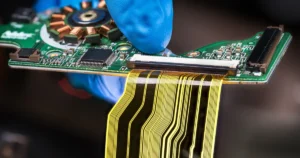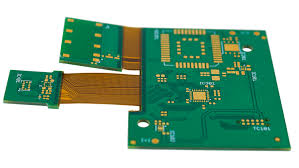- Overview
Deburring and gravimetric etching is an important process after CNC drilling and before chemical copper plating or direct copper plating of hard and soft bonded boards. To achieve reliable electrical interconnection of hard and soft bonded boards, appropriate deburring and gravimetric etching techniques must be selected for the special material composition of hard and soft bonded boards and for their main materials, polyimide and acrylic, which are not resistant to strong alkalis. The soft and hard bonding plate to drill dirt and cave etching technology is divided into wet technology and dry technology, the following two technologies and your peers to discuss together.
2. Wet de-drilling and gravimetric etching of soft and hard bonded plates
Wet deburring and cavitation of soft and hard bonded plates consists of the following three steps:
l Swelling (also called swelling treatment). The alcohol-ether swelling solution is used to soften the pore wall substrate and destroy the polymer structure, thus increasing the surface area that can be oxidized to make it easier for oxidation to take place, typically using butyl carbitol to swell the pore wall substrate.
l Oxidation. The purpose is to clean the pore wall and adjust the pore wall charge, currently, three ways are traditionally used in China. I. Concentrated sulfuric acid method: Because concentrated sulfuric acid has strong oxidation and water absorption, it can carbonize most of the resin and form alkyl sulfonates dissolved in water and removed, the reaction formula is as follows: CmH2nOn+H2SO4–mC+nH2O The effect of removing hole wall resin drilling stain is related to the concentration of concentrated sulfuric acid, treatment time and temperature of the solution. The concentration of concentrated sulfuric acid used to remove drilling stain should not be less than 86%, 20-40 seconds at room temperature, and if it is to be concave etching, the solution temperature should be increased and the treatment time extended. Concentrated sulfuric acid only works on resin, not on glass fiber. After using concentrated sulfuric acid to cavity etch the hole wall, there will be glass fiber head protruding from the hole wall, which needs to be treated with fluoride (such as ammonium hydrogen fluoride or hydrofluoric acid). When using fluoride to treat protruding glass fiber heads, the process conditions should also be controlled to prevent core absorption due to overcorrosion of the glass fibers, generally as follows:
H2SO4: 10%
NH4HF2: 5-10g/l
Temperature: 30°C Time: 3-5 minutes
After the drilling and denting of the hard and soft bonding plate according to this method, and then the metalization of the hole, the metallographic analysis showed that the inner layer of drilling and denting was not completely removed, resulting in low adhesion of the copper layer to the hole wall, for which the copper layer of the hole wall came off during the thermal stress test (288°C, 10±1 seconds) done in the metallographic analysis and resulted in the inner layer breaking.
Also, ammonium fluoride or hydrofluoric acid is massively toxic, and wastewater treatment is difficult. More to the point, polyimide is inert in concentrated sulfuric acid, so this method is not suitable for the de-drilling and denting of hard and soft bonded plates.
II. Chromic acid method: Because chromic acid has strong oxidation, its leaching ability is strong, so it can make the hole wall polymer material long chain break, and oxidation, sulfonation, and generate more hydrophilic groups on the surface, such as carbonyl (-C=O), hydroxyl (-OH), sulfonic acid group (-SO3H), etc., so as to improve its hydrophilicity, adjust the hole wall charge, and achieve the purpose of removing the hole wall drilling dirt and concave corrosion. The general process formulation is as follows:
Chromic anhydride CrO3 : 400 g/l
Sulfuric acid H2SO4 : 350 g/l
Temperature: 50-60°C Time: 10-15min
After the drilling and denting of the soft and hard bonded plate according to this method, the holes were then metalized, and the metallized holes were subjected to metallographic analysis and thermal stress tests, and the results were in full compliance with the GJB962A-32 standard.

So, the chromic acid method is also adapted for the de-drilling and concave etching of soft and hard bonded boards. For small companies, the method is indeed very suitable, simple and easy to operate, and more importantly, cost, but the only regret of the method is the presence of the toxic substance chromic anhydride. The only regret is the presence of the toxic substance chromic anhydride.
III. Alkaline potassium permanganate method: At present, many PCB manufacturers due to the lack of professional technology, still follow the rigid multilayer printed circuit board to remove the drilling and cavity etching technology – alkaline potassium permanganate technology to deal with soft and hard bonding board, through this method to remove the resin drilling stain, at the same time can etch the resin surface to produce small convex and concave pits on its surface, in order to improve the bonding between the hole wall coating and the substrate, in the high temperature and high alkali environment, the use of potassium permanganate oxidation to remove the swollen resin drilling stain, the system Under the high temperature and high alkali environment, the use of potassium permanganate oxidation to remove the swollen resin drill stain, the system for the general rigid multilayer board is very effective, but for the soft and hard combined board does not adapt, because the main body of the soft and hard combined board insulation substrate polyimide is not alkali-resistant, in the alkaline solution to swell or even a small part of the dissolution, not to mention the high temperature and high alkali environment. If this method is used, even if the hard and soft bonding board is not scrapped at that time, it will greatly reduce the reliability of the equipment that uses the hard and soft bonding board in the future.
l Neutralization. After the oxidation process, the substrate must be cleaned to prevent contamination of the activation solution in the later process, for which it must be neutralized and reduced. The process is based on the oxidation method.
3. Dry drilling stain removal and concave etching technology for soft and hard bonded panels
Currently, the popular dry method in China and abroad is the plasma deburring and cavitation technology. Plasma is used in the production of soft and hard bonded plates, mainly for hole wall decontamination and surface modification of the hole wall. The reaction can be seen as a highly activated state of the plasma and the hole wall polymer materials and glass fibers occur in the gas and solid phase chemical reaction, the resulting gas products and part of the unreacted particles are pumped away by the vacuum process, is a dynamic chemical reaction equilibrium process. According to the polymer material used in rigid-flexible printed circuit board, N2, O2, CF4 gas is usually chosen as the original gas. N2 is used for vacuum cleaning and preheating.
The schematic plasma chemical reaction of the O2+CF4 gas mixture is: O2+CF4 O+OF+CO+COF+F+e-+……. Plasma
Highly reactive oxygen radicals, fluorine radicals, etc. are generated by colliding O and F particles due to electric field acceleration into highly reactive particles, which react with polymer materials as follows:
[C,H,O,N]+[O+OF+CF3+CO+F+…] CO2+HF+H2O+NO2+……
The reaction of the plasma with the glass fiber is:
SiO2+[O+OF+CF3+CO+F+…] SiF4+CO2+CaL
This has enabled plasma treatment of rigid–flexible printed circuit boards.
It is worth noting that the addition of polar groups to the polymer bonds by the carbonylation of the atomic state O with C-H and C=C results in improved hydrophilicity on the surface of the polymeric material.
Soft and hard bonded plates treated with O2+CF4 plasma and then treated with O2 plasma not only result in improved pore wall wettability (hydrophilicity), but also remove the reaction. The end of the deposit and incomplete reaction of the midway products. Plasma technology to remove the drilling and denting method of treatment of hard and soft bonding plate and after direct plating, metallization hole metallographic analysis and thermal stress test, the results fully comply with the GJB962A-32 standard.
4. Closing remarks
In summary, whether dry or wet, if the appropriate method is chosen for the properties of the system’s host material, the rigid-flex interconnect master board can be achieved for the purpose of drilling smear and concave etching.














